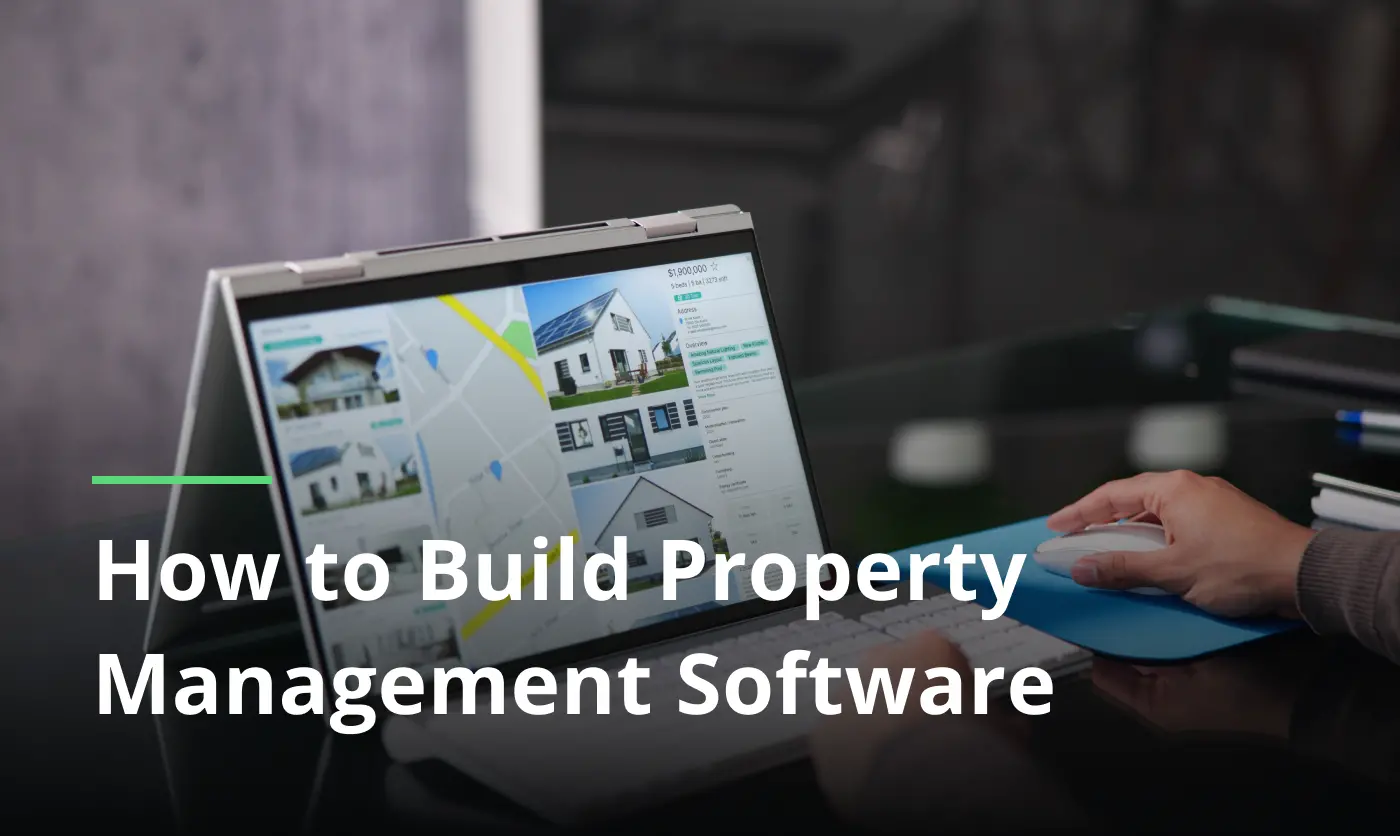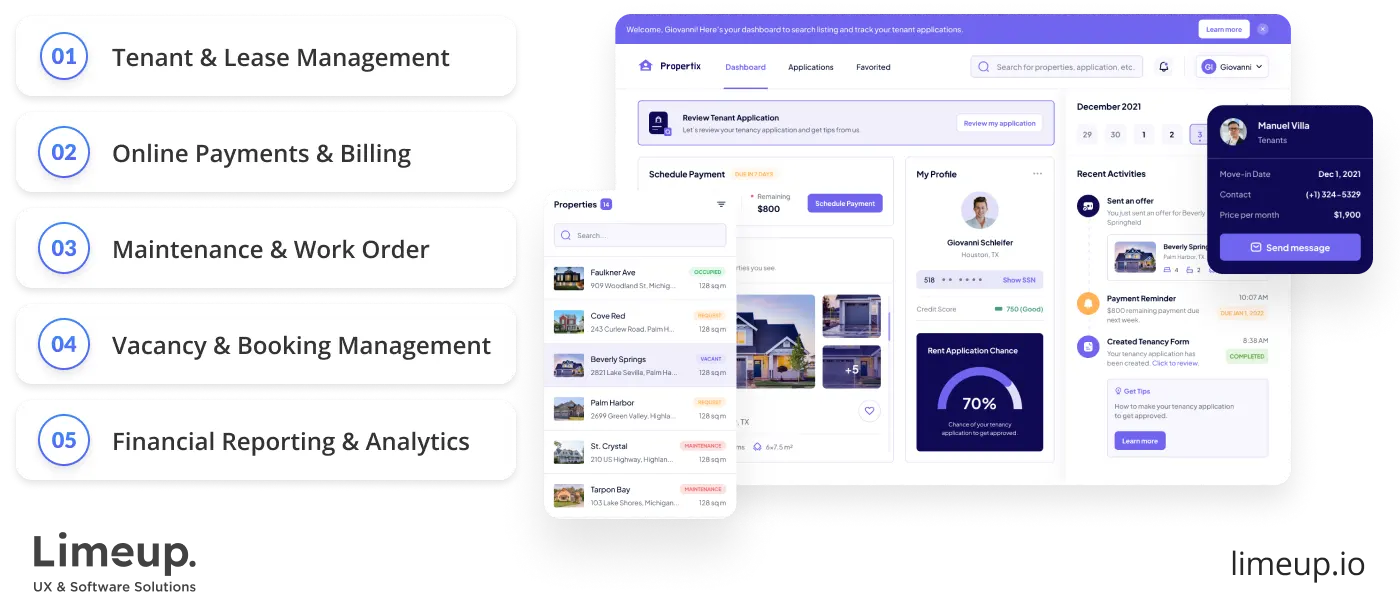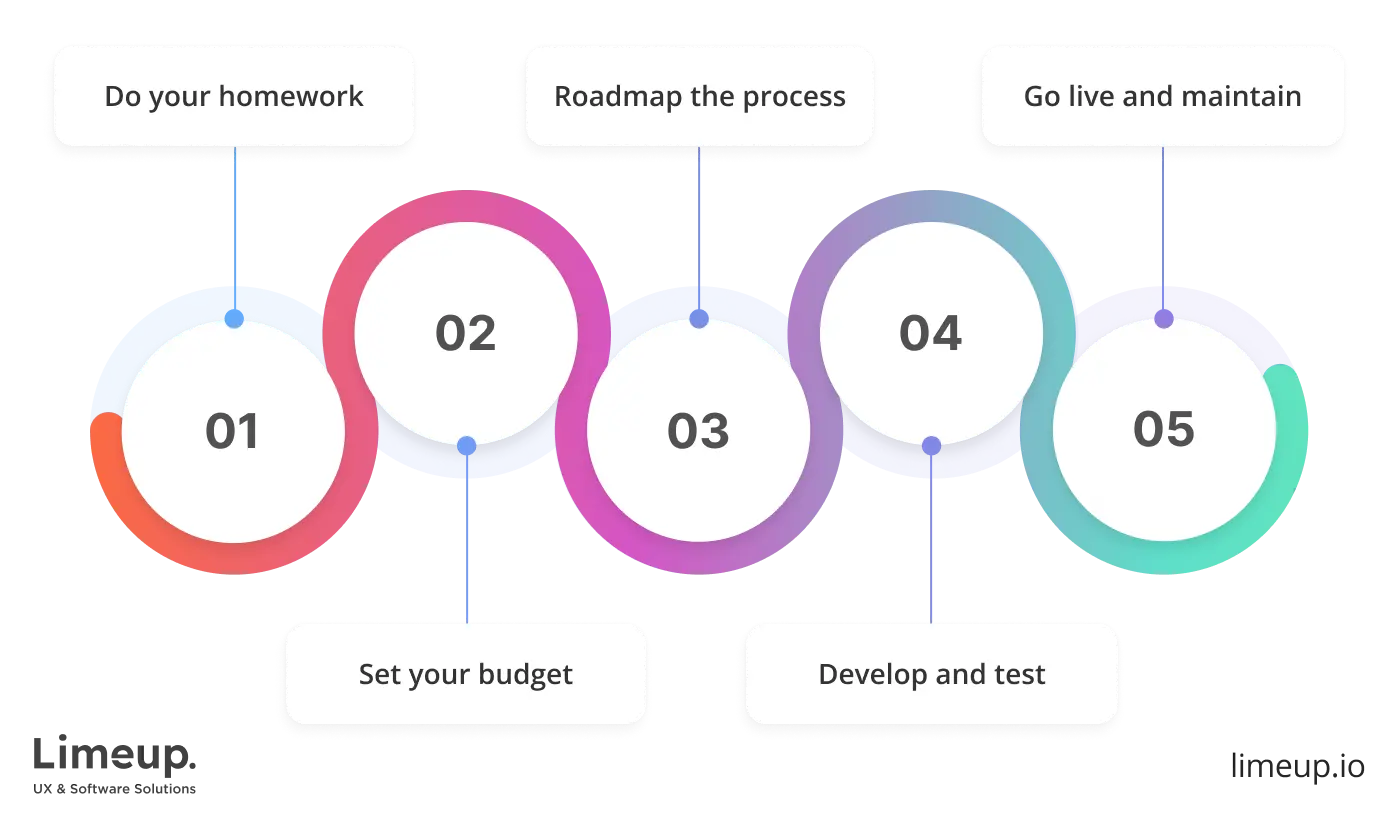How to Build Property Management Software: a Full Guide

Property management software development is the fast track to streamlined operations from rent collection to invoicing, enhanced financial management, and improved tenant administration. Complex but manageable, this process is comprehensively explained in our summary which covers vital topics of creation steps, features, pricing, and more.
If you are wondering what you need to create a property management system that will help you be in the driver’s seat of the cut-throat real estate industry, keep reading this material. Let’s navigate through the building roadmap with crucial factors that influence PMS solutions.
What is a property management system?
PMS, as the short form of such an application, is a software that helps real estate business owners, from hostels to enterprise organizations, to manage and centralize their manual and daily operations which expand to booking, controlling finances, advanced analytics reports, and more.

The real estate property management software development is aimed at platform creation, a separate service for modules creation according to unique requirements of a particular company, whether it’s CRM, reservation administration, or other demand we will consider through features in this material.
What are the steps for building property management software?
The stewardship of real estate-related business is a daunting process, and PMS is aimed at simplifying your operations. Still, according to our research through the latest statistics provided by IDC Report, companies can lose 20-30% of annual revenue using outdated management apps.
Contrarily, AppFolio Research indicates that 80% of property managers believe in automation as the way to improve profitability. You may ask, “That’s cool yet how do I reach the maximum and create such a solution effectively?” We have got you covered with 5 simple steps that take place based on our experience. Let’s dive into them.

— Step 1. Do your homework.
We were thinking about naming this stage “Conduct a well-though-our analysis,” “Define user pain points,” and “Know what you’re getting into” which sounds a little scary but in fact all of them are combined into one phase — determine your purpose.
“You have a similar firm as thousands of your competitors” is a widely spread theme, and we will say you are just operating in the same field, serving customers who are seeking resolutions to their problems. Therefore, defining your demands and end-users’ needs is the very first step to real estate management software development. Here’s what is recommended to be investigated:
- issues you have to solve with such a platform,
- target audience (landlords, managers, tenants, investors, etc.),
- intuitive user interface nuances,
- essential features (we will consider them in detail further).
— Step 2. Set your budget.
The second one goes for defining the amount of investments you are ready to divide as further it will impact functionality, the team size, implementation approach, and others. For instance, cooperating with real estate software development companies you receive more benefits but hiring freelancers will cost less.
Here, we recommend determining if you would like to receive a custom system built from scratch or pre-made one with limited features as building a property management software can be also conducted through while-label solution and low-code/no-code creation.
For brands with limited budgets, MVP can become a golden ticket to test core usability and save costs, while full performance is about the ability to expand attributes, all depending on your approach and capabilities.
— Step 3. Roadmap the process.
Assembling the crew of tech gurus comes into the game, as well as defining the methodology fitting your requirements, like Agile or Waterfall, setting clear timeframes, choosing the tech stack.
We have named a lot, right, and this step will be one of most time-consuming as you need to set up who will be involved, from engineers to project managers and QA. You have to outline all crucial factors that impact the final result before jumping into the actual creation.
— Step 4. Develop and test.
Here is where the property management software development begins, the actual building conducted by programmers you selected, according to the method you chose in the previous stage. Also, our advice is to provide manual and automated testing to ensure your code is bug-free and simultaneously avoid risks for the deployment.
QA experts will check every line, ensuring the functionality is saved and you are protected from future issues, especially when it comes to cost reduction, as you will not deal with unexpected after-release bugs.
— Step 5. Go live and maintain.
Here you go, after a long way through the digital ocean of creating an application, and for now, you will post in, gather feedback from users, and monitor overall performance. The ongoing support can be an additional stage but we have combined them as it starts right after PMS is available, which also can be included when you hire software developers.
We have outlined the whole journey to build a property management software which may seem like a lot of work to do but with a reliable group of tech wizards, you are able to receive the desired system. The next question stands for the part of being well-informed about needed characteristics, and we will reflect on them below.
What are the features of real estate management software development?
This aspect defines the final cost and deadlines as determining it before the collaboration with a provider you will avoid unnecessary functions, it also impacts scalability as you will be able to add more of them as your business grows.
Therefore, we have gathered together the vital parts which can’t be ignored, and all the others depend on your needs you will discuss with a vendor of your choice.

-
Leasing is about how you handle all the properties which can be followed by administration of tenants, with core mechanisms which cover storing all the agreements, screening through verifications, rental history, digital applications that automate sharing files and reduce paperwork (plus saves costs).
This feature is aimed at automatic execution mainly, saving your staff from time-consuming tasks and setting notifications if optioned so that no one will skip upcoming deadlines.
-
Collecting rent in the world of digitalization and property management software development also can be automated, collected in one system that includes the ability for tenants to pay online using their cards or Apple/Google Pay, Stripe, PayPal or else, and as they will receive a notification before the date expires, no delays are coming.
You are able to accept reports as well, tracking incomes, profit nuances, sync them with third-party apps for more convenience, all you can imagine, basically. This capability in real estate software development clears the path to more effective administration and simultaneously allows you to receive real-time insights to overview your weaknesses and opportunities.
-
Maintenance is a wide feature that includes the ability to keep an eye on your rent conditions, to be aware of any surroundings from alerts sent by your customers who can login in the system and form a request, add photos or else, while you will assign the work to masters.
It’s more about the communication and satisfaction as no one has to stress, being capable of solving all questions online, without even direct calls which is cool especially if your residents are in another city or even country.
-
Built-in tools for communication are another human-related function that will enable both you and clients to keep each other updated about any changes without the need to share third-party messengers or social media. You are able to fine-tune notifications, schedule messages, and more, all within rental property management software development.
-
Advanced analytics may seem similar to you since you definitely used it at least once, browsing some apps, chiefly business-related ones. Here, developers incorporate a plethora of data-driven visualizations that are easier to convert and understand, and the good news is that you choose the type of reports.
Do you need regular updates and overall information about revenue changes or cash flow from every transaction? — then you receive it, as well as payment history with the ability to download receipts, and even a bright and intuitive dashboard that depicts performance of key factors you select.
-
Integrations were named above so we can’t keep this intrigue and will say directly that additionally to payments we have outlines, you also can ask a property management software development company to connect tools and systems from CRM to e-signatures like PandaDoc or Adobe Sign.
It means that you and your consumers are free from switching between apps, for example, if you need to sign the updated policies as it can be done with doc administration functionality.
If you have thoughts about “What else?” then we will say that the only limit is budget for functions, since you are capable of receiving modules for in-app booking, performance tracking, guest management (for hotels plus hostels or providers with related services).
The real estate market is predicted to reach $727.80tn by 2029, so in order to stay in the frontline of competitors, receiving PMS will be a significant step that allows you to simplify administration and dedicate more time to urgent tasks.
For now, you are fully equipped to build your solution, and we have found the answer to how to develop a property management software that felt like dancing with darkness at the beginning. Stay tuned as we have to tell you more about the costs needed for such a project, so let’s drive to this point.
What is the price for a property management software development service?
As this question is hard to answer until we dive deeper into your needs, we still have what to put on the table to ensure that this query is not a scream trapped in a bottle once we open it.
We have fully explained this topic in our article dedicated to the software development cost if you are interested in overall pricing, and here, we will focus on apartment rental management software development and other functionalities in accordance with the level of complexity:
| PMS Type | Description | $ Estimation |
| Simple (basic) | It includes only some essential features, for instance, you can rely on tenant management, collecting rents online and sending alerts, etc. | $20,000–$49,999 |
| Moderate solution | This option opens more capabilities, from reporting on finances or housekeeping to integrations of CRM. | $50,000–149,999+ |
| Enterprise-grade | It has no limits unless your imaginations also apply for AI usage, which can enhance overall productivity and reduce manual work. | $150,000–$500,000+ |
To put it simply, factors affecting the final cost depend on the demands you determine in the first step we have studied above including UI/UX design, essential elements, the size of future product (read as the number of team members), property management software development services provider’s location if you choose an IT supplier or freelancers, tech stack and more.
We would like to note that ongoing maintenance will be charged additionally, according to the need of updates, bug fixing, security compliance, and other factors. For the precise definition of how much is required to be invested, our advice is to contact a reliable vendor and apply for a complimentary call.
Wrapping up
The bottom line on real estate property management software development is that a reliable solution will enhance your business, drive more revenue and attract customers who previously may not be your target audience.
Therefore, we have considered all crucial aspects, drawing a line between the definition for clarity, steps to build such a platform, features to implement so that the end-users will be satisfied, and what price you have to pay for such a system, or, as many of companies owners say, an investment.
Are you ready to receive your tailored real estate-based product? Then, consider contacting Limeup as we are one of the seasoned teams on the market with in-depth knowledge of trends and cutting-edge technologies to be used.
We will schedule a complimentary consultation to discuss your needs, and you will get a free project estimation with strategy and plan of the creation process. Schedule a meeting today, and our managers will reach out to you within a day.

